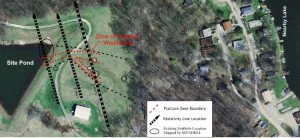Challenge
Mundell was hired by a property owner in southern Indiana to identify the locations of potential solution-enhanced features in the limestone bedrock, which may be acting as pathways for water transport from a site pond to a nearby lake. This area, known as the Mitchell Plain, is underlain by Middle Mississippian limestone formations which are very solution-prone. Despite previous attempts to plug visible sinkholes in the area, the water level of the pond had been slowly dropping.
Action
To map out voids and fractures across the site, Mundell utilized electromagnetic conductivity mapping and two-dimensional resistivity profiling to measure the variation in the electrical properties of the upper 100 feet of subsurface. Mundell collected conductivity data across the site (4 acre), and used the data to place three (3) resistivity profile lines in order to further characterize features of interest.
Results
The main feature of interest identified was a large fracture zone, ranging in width from 50 to 150 feet, which can be seen trending east-southeast from the northeastern corner of the pond towards a lake located east of the property. This zone (present on all three resistivity profiles) was likely acting as the primary mode of transport for the pond water to the lake, as well as leading to additional sinkhole development.
Mundell recommended that this feature must be addressed in order to minimize further excessive drainage of the pond by plugging these enhanced flow pathways by implementing a controlled grouting program.





